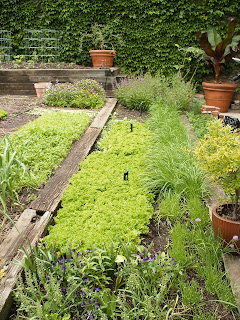
We saw all sorts of unique trees at Rich's Foxwillow Pines on Thursday afternoon. This is a weeping Norway spruce (Picea abies 'Reflexa'). I love the weeping habit! I almost made an impulse purchase of a weeping dwarf Canadian hemlock (Tsuga canadensis). I would like to get an appropriate container and then go back for it--it was really adorable! Here's another curiosity, a dwarf spruce with purple cones (Picea bicolor 'Howell's Dwarf'):

On Friday we visited the Chicago Botanic Garden, one of the horticultural jewels of the Chicagoland area. It didn't disappoint. I loved these Icelandic poppies en masse:

The rose garden was the only area that wasn't really exploding with blooms at this time, but it did have some lovely tree peonies.

This one is 'Age of Gold', and it had a very pleasant citrusy fragrance.
Here's a look at one of the native areas. The texture of prairie dropseed (Sporobolus heterolepis) with the shooting stars (Dodecatheon meadia) floating overhead is just gorgeous.

I'm not even sure which area this technically is part of, but I thought this was a beautiful waterfall surrounded by trees and greenery.

Contrast that naturalistic setting with the geometric clarity of the English Walled Garden:

As you can see, there is great diversity at the Garden. And this is just a sample of the gardens across the property. We covered a lot of ground there on Friday. This was no mean feat because the place is huge!
On Saturday we had a whirlwind tour of a number of gardens. First was Rick Bayless's private garden, which supplies much of the produce for his restaurant. Here's a look at some of the veggies and edible flowers. Note the banana tree in the container to the back right:

There were charming ornamental areas as well:

After a delicious lunch at Andie's (don't miss the baklava!!), Carolyn Gail of Sweet Home and Garden Chicago let us pore over her property. What a great Japanese maple!

Carolyn maximizes a small urban space with different forms, structures, and levels. She has seating, statues, a pond, vines, containers, and varied plantings. This picture captures just a fraction of that creativity with the hanging basket of petunias, clematis climbing the trellis wall of her outdoor seating (I don't know what type of structure that is technically--it's not a pergola, but I'm unsure what exactly to call it), a unique water feature, which Dee from Red Dirt Ramblings is also admiring, the pond in the back right, and a colorful bed surrounding it all:

Then it was on to the Ginkgo Organic Gardens in Wrigleyville, which supplies communally grown produce to a local charity. They devote a lot of space to greens because those are the most popular with the charity's recipients:

My last stop of the day was the Lincoln Park Conservatory, located near the shore of Lake Michigan. They have all sorts of tropical delights, but our southern bloggers explained that much of the Conservatory's collection can be grown in a typical garden in their region. It reminded me how harsh our climate here truly is! I can't imagine being able to grow anything remotely like this outdoors!

All in all it was a fantastic experience. The weather was mostly cooperative, and everyone seemed to enjoy our wonderful city. It was great to meet and get to know so many fun and friendly bloggers, and I hope everyone else had as good of a time as I did!

























